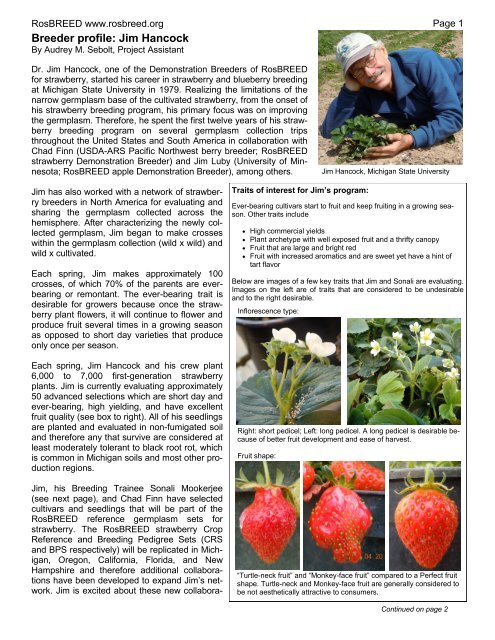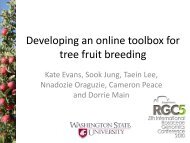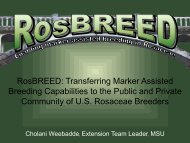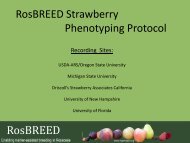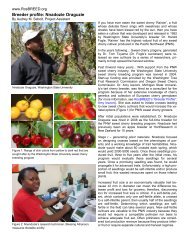Jim's RosBREED Demonstration Breeder Profile
Jim's RosBREED Demonstration Breeder Profile
Jim's RosBREED Demonstration Breeder Profile
Create successful ePaper yourself
Turn your PDF publications into a flip-book with our unique Google optimized e-Paper software.
<strong>RosBREED</strong> www.rosbreed.org<br />
<strong>Breeder</strong> profile: Jim Hancock<br />
By Audrey M. Sebolt, Project Assistant<br />
Dr. Jim Hancock, one of the <strong>Demonstration</strong> <strong>Breeder</strong>s of <strong>RosBREED</strong><br />
for strawberry, started his career in strawberry and blueberry breeding<br />
at Michigan State University in 1979. Realizing the limitations of the<br />
narrow germplasm base of the cultivated strawberry, from the onset of<br />
his strawberry breeding program, his primary focus was on improving<br />
the germplasm. Therefore, he spent the first twelve years of his strawberry<br />
breeding program on several germplasm collection trips<br />
throughout the United States and South America in collaboration with<br />
Chad Finn (USDA-ARS Pacific Northwest berry breeder; <strong>RosBREED</strong><br />
strawberry <strong>Demonstration</strong> <strong>Breeder</strong>) and Jim Luby (University of Minnesota;<br />
<strong>RosBREED</strong> apple <strong>Demonstration</strong> <strong>Breeder</strong>), among others.<br />
Page 1<br />
Jim Hancock, Michigan State University<br />
Jim has also worked with a network of strawberry<br />
breeders in North America for evaluating and<br />
sharing the germplasm collected across the<br />
hemisphere. After characterizing the newly collected<br />
germplasm, Jim began to make crosses<br />
within the germplasm collection (wild x wild) and<br />
wild x cultivated.<br />
Each spring, Jim makes approximately 100<br />
crosses, of which 70% of the parents are everbearing<br />
or remontant. The ever-bearing trait is<br />
desirable for growers because once the strawberry<br />
plant flowers, it will continue to flower and<br />
produce fruit several times in a growing season<br />
as opposed to short day varieties that produce<br />
only once per season.<br />
Each spring, Jim Hancock and his crew plant<br />
6,000 to 7,000 first-generation strawberry<br />
plants. Jim is currently evaluating approximately<br />
50 advanced selections which are short day and<br />
ever-bearing, high yielding, and have excellent<br />
fruit quality (see box to right). All of his seedlings<br />
are planted and evaluated in non-fumigated soil<br />
and therefore any that survive are considered at<br />
least moderately tolerant to black root rot, which<br />
is common in Michigan soils and most other production<br />
regions.<br />
Jim, his Breeding Trainee Sonali Mookerjee<br />
(see next page), and Chad Finn have selected<br />
cultivars and seedlings that will be part of the<br />
<strong>RosBREED</strong> reference germplasm sets for<br />
strawberry. The <strong>RosBREED</strong> strawberry Crop<br />
Reference and Breeding Pedigree Sets (CRS<br />
and BPS respectively) will be replicated in Michigan,<br />
Oregon, California, Florida, and New<br />
Hampshire and therefore additional collaborations<br />
have been developed to expand Jim’s network.<br />
Jim is excited about these new collabora-<br />
Traits of interest for Jim’s program:<br />
Ever-bearing cultivars start to fruit and keep fruiting in a growing season.<br />
Other traits include<br />
High commercial yields<br />
Plant archetype with well exposed fruit and a thrifty canopy<br />
Fruit that are large and bright red<br />
Fruit with increased aromatics and are sweet yet have a hint of<br />
tart flavor<br />
Below are images of a few key traits that Jim and Sonali are evaluating.<br />
Images on the left are of traits that are considered to be undesirable<br />
and to the right desirable.<br />
Inflorescence type:<br />
Right: short pedicel; Left: long pedicel. A long pedicel is desirable because<br />
of better fruit development and ease of harvest.<br />
Fruit shape:<br />
“Turtle-neck fruit” and “Monkey-face fruit” compared to a Perfect fruit<br />
shape. Turtle-neck and Monkey-face fruit are generally considered to<br />
be not aesthetically attractive to consumers.<br />
Continued on page 2
Volume 2 Issue 2<br />
<strong>Breeder</strong> profile continued<br />
Page 2<br />
Jim Hancock in Ecuador (1996) using highly sophisticated<br />
scientific techniques for extracting seeds from<br />
fruit<br />
tions and the opportunity to see how his selections will perform<br />
in the states of Florida and California, which are warmer<br />
climates. All five locations will evaluate the CRS and BPS for<br />
the traits indicated in the strawberry standardized phenotyping<br />
protocol (www.rosbreed.org/resources/fruit-evaluation).<br />
Recently, Jim’s program was visited by Jerry Hill, whose<br />
<strong>RosBREED</strong> Team is developing a breeding information management<br />
system. One of its many capabilities is that it manages<br />
breeders’ trait data and assists with cross planning. Jim<br />
is excited about the new system because he believes it will<br />
be an excellent tool for designing crosses; he will be able to<br />
more easily visualize the pedigree of selections of interest<br />
along with their traits. Jim may consider making diverse<br />
crosses if the system reveals potentially new and exciting<br />
cross combinations. In addition to providing an excellent management tool for parent and seedling selection,<br />
the data management system will also serve as a catalog for future breeders that may use his germplasm<br />
and trait data. Stay tuned for the next issue of our Newsletter where we will describe this data management<br />
system in more detail.<br />
Meet Jim’s Breeding Trainee: Sonali Mookerjee<br />
Sonali Mookerjee in East Lansing (2011)<br />
using current highly sophisticated scientific<br />
techniques<br />
Why did you choose Jim Hancock’s program? When I joined the<br />
Plant Breeding, Genetics, and Biotechnology Program at MSU, I wanted<br />
to get training in plant breeding. I had been working with apples, so I<br />
had a preference for continuing to work with a crop in the same family.<br />
Dr. Jim Hancock had this project on strawberry breeding that I could<br />
work on and that would give me the opportunity to get experience in<br />
traditional, as well as molecular breeding. I could also participate in the<br />
<strong>RosBREED</strong> project and gain from all the valuable resources in<br />
<strong>RosBREED</strong>. I am extremely thankful to Dr. Hancock that he let me<br />
work with him because this was possibly the best breeding training I<br />
could hope for. Dr. Hancock’s enthusiasm, optimism, and encouragement,<br />
makes research so much fun!<br />
What is your thesis project if it has been determined? I am developing<br />
a linkage map for octoploid strawberry using SSR markers. I will<br />
be using this map to identify QTL linked to photoperiod and temperature<br />
regulation of flowering in strawberry and identify markers linked to<br />
these traits.<br />
What benefits have you seen by being part of <strong>RosBREED</strong>? Being a <strong>RosBREED</strong> Project Assistant gives<br />
me the opportunity to be a part of this unique effort of implementing marker-assisted breeding into traditional<br />
breeding in Rosaceous crops. It gives me the opportunity to understand and follow streamlined research<br />
efforts involving many branches of science, many institutions, and many researchers with a common goal. I<br />
am able to interact with breeders, scientists, and graduate students from so many research institutions. I can<br />
contribute to a unique multi-state strawberry pedigree-based analysis project which will produce a lot of valuable<br />
information for all strawberry breeders/scientists. I get the opportunity to participate in the workshops<br />
on Pedigree-Based Analysis, an area that I was not familiar with.


